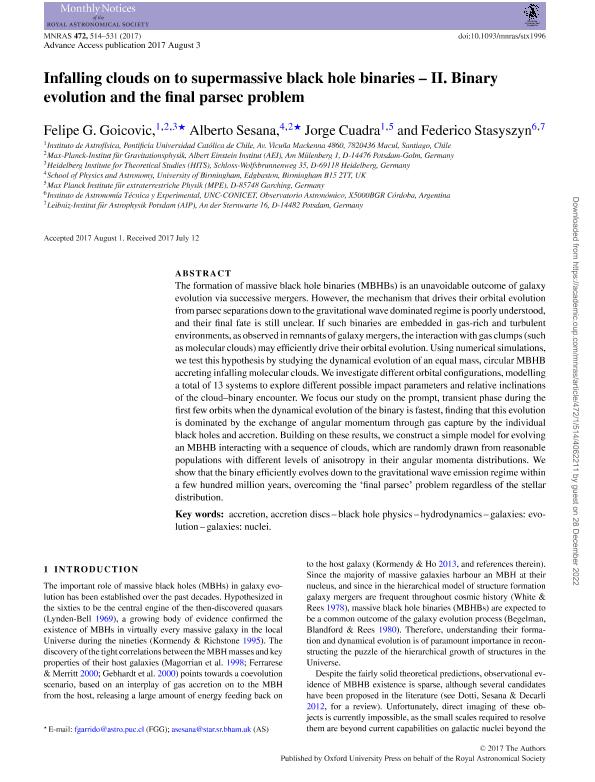Mostrar el registro sencillo del ítem
dc.contributor.author
Goicovic, Felipe G.
dc.contributor.author
Sesana, Alberto
dc.contributor.author
Cuadra, Jorge
dc.contributor.author
Stasyszyn, Federico Andres

dc.date.available
2023-01-03T13:32:44Z
dc.date.issued
2017-11
dc.identifier.citation
Goicovic, Felipe G.; Sesana, Alberto; Cuadra, Jorge; Stasyszyn, Federico Andres; Infalling clouds on to supermassive black hole binaries - II. Binary evolution and the final parsec problem; Wiley Blackwell Publishing, Inc; Monthly Notices of the Royal Astronomical Society; 472; 1; 11-2017; 514-531
dc.identifier.issn
0035-8711
dc.identifier.uri
http://hdl.handle.net/11336/183146
dc.description.abstract
The formation of massive black hole binaries (MBHBs) is an unavoidable outcome of galaxy evolution via successive mergers. However, the mechanism that drives their orbital evolution from parsec separations down to the gravitationalwave dominated regime is poorly understood, and their final fate is still unclear. If such binaries are embedded in gas-rich and turbulent environments, as observed in remnants of galaxy mergers, the interactionwith gas clumps (such as molecular clouds)may efficiently drive their orbital evolution. Using numerical simulations, we test this hypothesis by studying the dynamical evolution of an equal mass, circular MBHB accreting infallingmolecular clouds.We investigate different orbital configurations,modelling a total of 13 systems to explore different possible impact parameters and relative inclinations of the cloud-binary encounter. We focus our study on the prompt, transient phase during the first few orbits when the dynamical evolution of the binary is fastest, finding that this evolution is dominated by the exchange of angular momentum through gas capture by the individual black holes and accretion. Building on these results, we construct a simple model for evolving an MBHB interacting with a sequence of clouds, which are randomly drawn from reasonable populations with different levels of anisotropy in their angular momenta distributions. We show that the binary efficiently evolves down to the gravitational wave emission regime within a few hundred million years, overcoming the 'final parsec' problem regardless of the stellar distribution.
dc.format
application/pdf
dc.language.iso
eng
dc.publisher
Wiley Blackwell Publishing, Inc

dc.rights
info:eu-repo/semantics/openAccess
dc.rights.uri
https://creativecommons.org/licenses/by-nc-sa/2.5/ar/
dc.subject
ACCRETION, ACCRETION DISCS
dc.subject
BLACK HOLE PHYSICS
dc.subject
GALAXIES: EVOLUTION
dc.subject
GALAXIES: NUCLEI
dc.subject
HYDRODYNAMICS
dc.subject.classification
Astronomía

dc.subject.classification
Ciencias Físicas

dc.subject.classification
CIENCIAS NATURALES Y EXACTAS

dc.title
Infalling clouds on to supermassive black hole binaries - II. Binary evolution and the final parsec problem
dc.type
info:eu-repo/semantics/article
dc.type
info:ar-repo/semantics/artículo
dc.type
info:eu-repo/semantics/publishedVersion
dc.date.updated
2022-12-06T17:26:52Z
dc.identifier.eissn
1365-2966
dc.journal.volume
472
dc.journal.number
1
dc.journal.pagination
514-531
dc.journal.pais
Reino Unido

dc.journal.ciudad
Londres
dc.description.fil
Fil: Goicovic, Felipe G.. Pontificia Universidad Católica de Chile; Chile. Max-Planck-Institut für Gravitationsphysik; Alemania. Heidelberg Institute for Theoretical Studies; Alemania
dc.description.fil
Fil: Sesana, Alberto. Max-Planck-Institut für Gravitationsphysik; Alemania. University of Birmingham; Reino Unido
dc.description.fil
Fil: Cuadra, Jorge. Pontificia Universidad Católica de Chile; Chile. Institut Max Planck fuer Gesellschaft. Max Planck Institute for Extraterrestrial Physics; Alemania
dc.description.fil
Fil: Stasyszyn, Federico Andres. Leibniz-Institut für Astrophysik Potsdam; Alemania. Consejo Nacional de Investigaciones Científicas y Técnicas. Centro Científico Tecnológico Conicet - Córdoba. Instituto de Astronomía Teórica y Experimental. Universidad Nacional de Córdoba. Observatorio Astronómico de Córdoba. Instituto de Astronomía Teórica y Experimental; Argentina
dc.journal.title
Monthly Notices of the Royal Astronomical Society

dc.relation.alternativeid
info:eu-repo/semantics/altIdentifier/url/https://academic.oup.com/mnras/article/472/1/514/4062211
dc.relation.alternativeid
info:eu-repo/semantics/altIdentifier/doi/https://doi.org/10.1093/mnras/stx1996
dc.relation.alternativeid
info:eu-repo/semantics/altIdentifier/url/https://arxiv.org/abs/1602.01966
Archivos asociados
